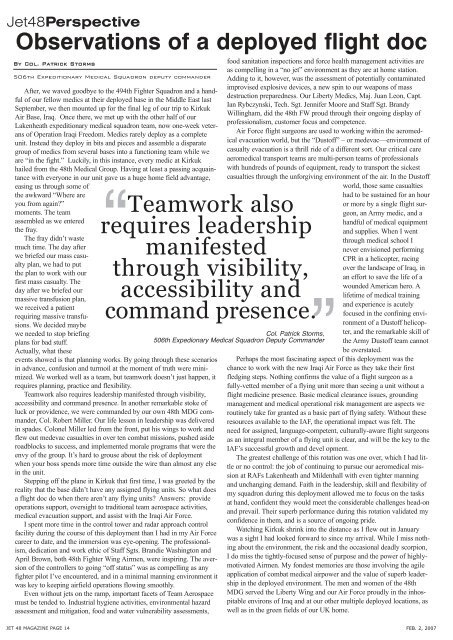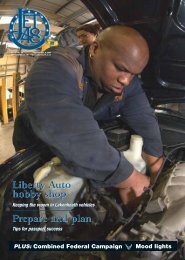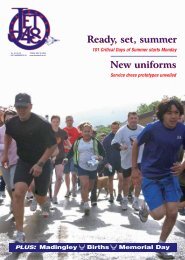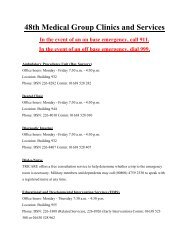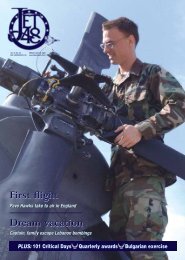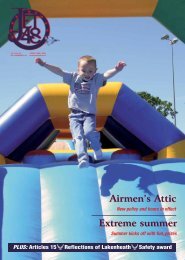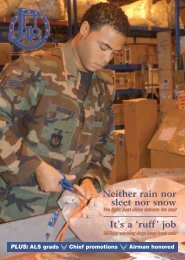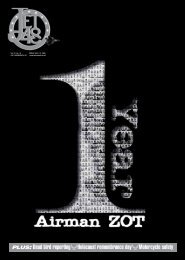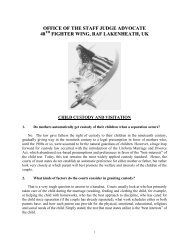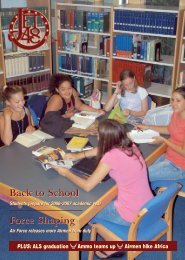02 - RAF Lakenheath
02 - RAF Lakenheath
02 - RAF Lakenheath
You also want an ePaper? Increase the reach of your titles
YUMPU automatically turns print PDFs into web optimized ePapers that Google loves.
Jet48Perspective<br />
Observations of a deployed flight doc<br />
By Col. Patrick Storms<br />
506th Expeditionary Medical Squadron deputy commander<br />
After, we waved goodbye to the 494th Fighter Squadron and a handful<br />
of our fellow medics at their deployed base in the Middle East last<br />
September, we then mounted up for the final leg of our trip to Kirkuk<br />
Air Base, Iraq. Once there, we met up with the other half of our<br />
<strong>Lakenheath</strong> expeditionary medical squadron team, now one-week veterans<br />
of Operation Iraqi Freedom. Medics rarely deploy as a complete<br />
unit. Instead they deploy in bits and pieces and assemble a disparate<br />
group of medics from several bases into a functioning team while we<br />
are “in the fight.” Luckily, in this instance, every medic at Kirkuk<br />
hailed from the 48th Medical Group. Having at least a passing acquaintance<br />
with everyone in our unit gave us a huge home field advantage,<br />
easing us through some of<br />
“<br />
the awkward “Where are<br />
Teamwork also<br />
requires leadership<br />
manifested<br />
through visibility,<br />
accessibility and<br />
command presence.<br />
you from again”<br />
moments. The team<br />
assembled as we entered<br />
the fray.<br />
The fray didn’t waste<br />
much time. The day after<br />
we briefed our mass casualty<br />
plan, we had to put<br />
the plan to work with our<br />
first mass casualty. The<br />
day after we briefed our<br />
massive transfusion plan,<br />
we received a patient<br />
requiring massive transfusions.<br />
We decided maybe<br />
we needed to stop briefing<br />
plans for bad stuff.<br />
Actually, what these<br />
events showed is that planning works. By going through these scenarios<br />
in advance, confusion and turmoil at the moment of truth were minimized.<br />
We worked well as a team, but teamwork doesn’t just happen, it<br />
requires planning, practice and flexibility.<br />
Teamwork also requires leadership manifested through visibility,<br />
accessibility and command presence. In another remarkable stoke of<br />
luck or providence, we were commanded by our own 48th MDG commander,<br />
Col. Robert Miller. Our life lesson in leadership was delivered<br />
in spades. Colonel Miller led from the front, put his wings to work and<br />
flew out medevac casualties in over ten combat missions, pushed aside<br />
roadblocks to success, and implemented morale programs that were the<br />
envy of the group. It’s hard to grouse about the risk of deployment<br />
when your boss spends more time outside the wire than almost any else<br />
in the unit.<br />
Stepping off the plane in Kirkuk that first time, I was greeted by the<br />
reality that the base didn’t have any assigned flying units. So what does<br />
a flight doc do when there aren’t any flying units Answers: provide<br />
operations support, oversight to traditional team aerospace activities,<br />
medical evacuation support, and assist with the Iraqi Air Force.<br />
I spent more time in the control tower and radar approach control<br />
facility during the course of this deployment than I had in my Air Force<br />
career to date, and the immersion was eye-opening. The professionalism,<br />
dedication and work ethic of Staff Sgts. Brandie Washington and<br />
April Brown, both 48th Fighter Wing Airmen, were inspiring. The aversion<br />
of the controllers to going “off status” was as compelling as any<br />
fighter pilot I’ve encountered, and in a minimal manning environment it<br />
was key to keeping airfield operations flowing smoothly.<br />
Even without jets on the ramp, important facets of Team Aerospace<br />
must be tended to. Industrial hygiene activities, environmental hazard<br />
assessment and mitigation, food and water vulnerability assessments,<br />
food sanitation inspections and force health management activities are<br />
as compelling in a “no jet” environment as they are at home station.<br />
Adding to it, however, was the assessment of potentially contaminated<br />
improvised explosive devices, a new spin to our weapons of mass<br />
destruction preparedness. Our Liberty Medics, Maj. Juan Leon, Capt.<br />
Ian Rybczynski, Tech. Sgt. Jennifer Moore and Staff Sgt. Brandy<br />
Willingham, did the 48th FW proud through their ongoing display of<br />
professionalism, customer focus and competence.<br />
Air Force flight surgeons are used to working within the aeromedical<br />
evacuation world, but the “Dustoff” – or medevac—environment of<br />
casualty evacuation is a thrill ride of a different sort. Our critical care<br />
aeromedical transport teams are multi-person teams of professionals<br />
with hundreds of pounds of equipment, ready to transport the sickest<br />
casualties through the unforgiving environment of the air. In the Dustoff<br />
world, those same casualties<br />
had to be sustained for an hour<br />
or more by a single flight surgeon,<br />
an Army medic, and a<br />
handful of medical equipment<br />
and supplies. When I went<br />
through medical school I<br />
never envisioned performing<br />
CPR in a helicopter, racing<br />
over the landscape of Iraq, in<br />
an effort to save the life of a<br />
wounded American hero. A<br />
lifetime of medical training<br />
and experience is acutely<br />
focused in the confining environment<br />
of a Dustoff helicopter,<br />
and the remarkable skill of<br />
the Army Dustoff team cannot<br />
be overstated.<br />
”<br />
Perhaps the most fascinating aspect of this deployment was the<br />
chance to work with the new Iraqi Air Force as they take their first<br />
fledging steps. Nothing confirms the value of a flight surgeon as a<br />
fully-vetted member of a flying unit more than seeing a unit without a<br />
flight medicine presence. Basic medical clearance issues, grounding<br />
management and medical operational risk management are aspects we<br />
routinely take for granted as a basic part of flying safety. Without these<br />
resources available to the IAF, the operational impact was felt. The<br />
need for assigned, language-competent, culturally-aware flight surgeons<br />
as an integral member of a flying unit is clear, and will be the key to the<br />
IAF’s successful growth and devel opment.<br />
The greatest challenge of this rotation was one over, which I had little<br />
or no control: the job of continuing to pursue our aeromedical mission<br />
at <strong>RAF</strong>s <strong>Lakenheath</strong> and Mildenhall with even tighter manning<br />
and unchanging demand. Faith in the leadership, skill and flexibility of<br />
my squadron during this deployment allowed me to focus on the tasks<br />
at hand, confident they would meet the considerable challenges head-on<br />
and prevail. Their superb performance during this rotation validated my<br />
confidence in them, and is a source of ongoing pride.<br />
Watching Kirkuk shrink into the distance as I flew out in January<br />
was a sight I had looked forward to since my arrival. While I miss nothing<br />
about the environment, the risk and the occasional deadly scorpion,<br />
I do miss the tightly-focused sense of purpose and the power of highlymotivated<br />
Airmen. My fondest memories are those involving the agile<br />
application of combat medical airpower and the value of superb leadership<br />
in the deployed environment. The men and women of the 48th<br />
MDG served the Liberty Wing and our Air Force proudly in the inhospitable<br />
environs of Iraq and at our other multiple deployed locations, as<br />
well as in the green fields of our UK home.<br />
Col. Patrick Storms,<br />
506th Expedionary Medical Squadron Deputy Commander<br />
JET 48 MAGAZINE PAGE 14 FEB. 2, 2007


